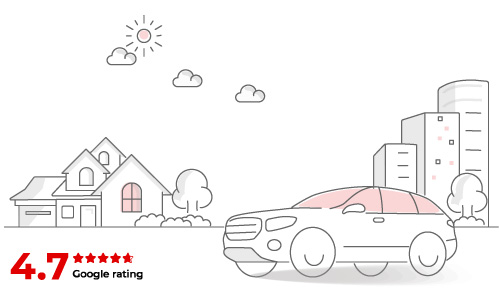
Written by Kayla Jane Barrie Updated on Dec 12, 2025 7 mins read

How much do you know about car ownership in Ontario? What happens when you need to transfer vehicle ownership?
People in Ontario buy and sell cars every day. Upon completing the transaction, you become the vehicle owner whether you buy new or used. You have the car ownership papers, and the vehicle is registered in your name.
This blog looks at the types of ownership, costs, how to transfer it to family or when selling your vehicle, and what to do with your car insurance quotes.
Most people associate ownership in Ontario with the green piece of paper issued by the province. Some refer to it as the vehicle title or vehicle permit. You receive this document when you buy a car from a dealership or transfer it during a private sale. It includes the following information:
Yes, you are required to carry your vehicle permit with you when you drive. Most people store it in their glove box. You will be asked to produce this permit — to verify that you are the legal owner of the vehicle you are driving — if the police pull you over.
Vehicle ownership involves purchasing a car. The permit is a green piece of paper provided by the seller. Vehicle registration involves registering your vehicle with the province of Ontario.
You will need proof of insurance, a valid license plate and a plate sticker. This process can be completed at any ServiceOntario location.
Lost car ownership papers are a common occurrence. You can replace lost, damaged, or stolen car papers at ServiceOntario. The replacement cost is $32. Bring identification, driver’s license, and proof of valid car insurance in Ontario.
It is legally possible to have joint car ownership in Ontario. Joint ownership means that two or more people share a vehicle's ownership rights and responsibilities. This arrangement generally involves listing both parties on the vehicle's registration and title documents.
When you purchase a vehicle with someone else, it's important to clarify the terms of ownership. This includes issues such as Ontario auto insurance, financial responsibilities, and decision-making authority regarding the vehicle. It's advisable to consult with legal professionals or relevant authorities to ensure that the ownership arrangement complies with Ontario's laws and regulations. These laws and regulations may vary depending on specific circumstances.
Yes, you can add two names. Most people do so to qualify for car loans and make driving more affordable. It’s increasingly common for friends, roommates, and relatives to share it. Be sure to have occasional driver insurance set up, and you'll be ready to hit the road.
Yes, you can put ownership under your parents’ name. Many parents purchase vehicles for their children and put them under their names. The child can also have their name added to the title.
In Ontario, it will cost $32. This applies to all types of vehicles. This fee is often lumped into the total buying cost and listed on the car bill of sale. Learn more about the total costs of own and drive a car in the province.
Whether you are buying a used car or selling a car in Ontario, it’s important to be aware of the laws associated with the transfer of ownership. Transferring it can happen between a dealership and a buyer, a private sale, or through family members.
It is also worth noting that the transfer process involves several steps, including obtaining a used vehicle information package, completing the transfer application form, and paying the applicable fees. Once the transfer process is complete, the buyer will receive a new permit with their name as the vehicle's registered owner.
Before we outline the steps required for a transfer, there are a few terms you need to become familiar with:
Under the Highway Traffic Act, sellers are legally required to provide the UVIP to a buyer during a private sale. The used vehicle information package provides buyers with important information, including:
The safety standards certificate confirms that a vehicle meets minimum safety standards on the date it was inspected and the certificate was granted. The certificate is required when transferring a used vehicle to a new owner. This is not needed when you transfer a car to a spouse. The certificate is valid for 36 days and can be obtained by any inspection station licensed by the MTO. Price varies by location.
You can transfer vehicle ownership to most family members as a gift. This includes a spouse, parents, grandparents, children, siblings and in-laws. You do not have to pay retail sales tax when you transfer.
To complete an ownership transfer to the family, you need to provide the following documentation to Service Ontario:
Transferring ownership after death can play out in several ways. The executor of the will must visit ServiceOntario and provide a copy of the will, vehicle ownership papers, personal identification, proof of insurance, and proof of death certificate to transfer to a beneficiary.
If the spouse is the executor of the will and the vehicle is being transferred to a family member, the rules for transferring ownership of a vehicle to a family member apply.
If two married people have a jointly owned vehicle, the surviving person can transfer the ownership into their name. A death certificate will be required to complete the transfer of a car after a death.
If the deceased does not have a will, the executor must prove the recipient of the vehicle is entitled to it. You can get a letter of opinion drafted by your lawyer and present it to the Ministry of Transportation.
Once you’ve found a vehicle and have agreed on payment terms, here is how to complete the used vehicle transfer of ownership process for buyers:
Here are the steps for the buyer to transfer it:
Follow these steps if you are the seller transferring ownership of a used vehicle:
Remember, the vehicle will remain registered in the seller’s name until the buyer at Service Ontario completes the vehicle transfer process. You remain legally liable for it until the transfer is complete. Therefore, you should follow up with the buyer to ensure the transfer is successful. Maintain proof of the transfer.
A vehicle permit with the correct owner's name is crucial when filing a car insurance claim. This is because the compensation will be given to the person listed as the owner of the permit. It is important to note that the permit serves as proof of ownership and registration of the vehicle. You cannot legally operate the vehicle on public roads without a permit.
When buying a used vehicle, complete the transfer process at ServiceOntario as soon as possible. Until the transfer is complete, the seller is legally liable for the vehicle. Ensure you have the correct permit with your name to avoid liability issues in case of accidents or other legal matters.
No. You cannot change car ownership online. You must visit a ServiceOntario location to show proof of ownership, insurance, and other documents.
You can change your address on your vehicle permit online. However, you will need to visit any ServiceOntario location to pick up your updated car ownership papers. You will need to bring your old permit with you. If you do not have your old permit, you must pay a $32 fee.
Lost car ownership papers are a common occurrence. You can replace lost, damaged, or stolen car papers at ServiceOntario. The replacement cost is $32. Bring identification, your driver’s license, and proof of valid car insurance in Ontario with you.
There are a number of situations when you may need to show proof, including:
Yes, you can transfer a car with a lien or outstanding debt. Buying a car with a lien can be a risk. If the lien is not paid, the debt holder has the right to repossess the vehicle from the person who owes the money OR from the buyer of the car.
Always check the lien information on the Used Vehicle Information Package.
| Categories | Industry NewsAuto |
|---|---|
| Tags | Tips and AdviceReports and GuidesLicence |
Read our insurance blog to get helpful tips, information and news.
Has your car been totalled in an accident? Is your car a write off? Learn about vehicle write offs for a total loss insurance claim.
Get the facts on Toronto's auto theft problem. We break down the data, reveal the most-stolen vehicles (including the Honda CR-V and Lexus RX 350), and show which neighbourhoods are most affected.
Dive into the world of auto theft with our blog on the most stolen cars in Canada. See the most stolen cars across Canada, including provincial lists for Ontario and Quebec, and learn how high-risk models can affect your car insurance premiums.
Drive safe this winter! Check out these tips for driving in snowy and icy conditions in Ontario. Get other helpful info and FAQs on winter driving.